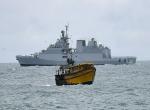The changes in a nation’s threat perception define the need for new defense policy guidelines. Based on this premise, Japan’s new National Defense Policy Guidelines (NDPG) 2010, shows a marked shift in Japan’s threat perception from non-conventional to conventional security threats. The characterization of ‘China’s military modernization and insufficient transparency as a matter of concern’, illustrates the changed perception of Japan towards China from its earlier policy guideline of 2004, where it just mentioned the need to be attentive to China’s actions.
Widening the scope of Article IX of the Constitution, under which Japan renounced the use of force in settling international disputes, Japan’s new policy to build ‘Dynamic Defense Force’ in place of ‘Basic Defense Force’, and the provision for the ‘use of Self Defense Forces (SDFs) in various type of situations in Japan’s offshore islands’, demonstrates the fact that Japan’s new policy guidelines are to make its forces more proactive in responding to any external situation. The notable difference between the ‘Basic Defense Force’ and ‘Dynamic Defense Force’ being that the former was aimed to secure deterrence by existence per se of defense capability, the later aims to increase Japan’s deterrent capability by promoting timely and active operations.
While 2004 NDPG only defined the basic objective of Japan’s security policy as ‘to prevent and repel external threat from reaching Japan’, and ‘to improve international security environment to reduce the chances that any threat would reach Japan’, the addition of a third objective to the Japan’s security policy that is ‘securing global peace and stability and ensuring human security’, further boosts the point that Japan is trying to make its policy more proactive, so as to increase its say in the wider global activities and in turn secure its strategic interests.
Moreover, in concert with the changing realities of the time, Japan has also widened the framework of its security cooperation. Thus, the new NDPG not only mentions the widening of US-Japan alliance in the area of Cyberspace, but also states that Japan would enhance security cooperation with Republic of Korea (ROK), Australia, ASEAN countries, and India. The enhancement of security cooperation with other countries underlines the fact that Japan recognizes the relative change in US’s influence in the region with the rise of new powers, and therefore wants to broaden the security cooperation with other countries to hedge its future security interests.
The other significant change introduced in Japan’s policy is the proposal to build Cyber defense, to strengthen the information security system. The proposal to build Cyber defense is in tune with the threats of cyber attacks on information and telecommunications networks which can affect military command and control networks, as well as common people’s daily lives.
In addition to these changes the new policy guideline has also proposed to establish a security policy coordinating body at Prime Minister’s Office involving relevant ministries, which would also act as an advisory body to the Prime Minister. This reflects the fact that Japan wants to promote effective and efficient defense administration in order to respond quickly to any emergent crisis situation. In recent times, Japanese people’s trust in the Ministry of Defense and SDF was severely damaged as it gave way to diplomatic pressures from other countries, for instance, the release of Chinese captain following the fishing boat incident in September, the increasing Chinese and Russian activities in the waters near Japan, and frequent violations of Japanese airspace. In FY 2009, out of 299 scrambles undertaken by Air Self Defense Forces of Japan, approximately 80 per cent of scrambles were against Russian or Chinese aircraft (Defense of Japan 2010). These incidents have enraged Japanese people from time to time.
In this backdrop the question arises where these changes would ultimately lead to? Do these changes reflect the fact that Japan’s security policy is undergoing a strategic shift, which may ultimately lead it to become a normal military power? In light of the conflicting interests of the nation-states in the region and the emergent situations, this seems to be the case.
The security environment surrounding Japan has become increasingly unstable, creating a security dilemma for Japan. North Korea’s military and missile developments, the modernization of China’s armed forces, and the intensification of military activities by China and Russia, have created a climate that has led Japan to change its policies. The recent developments in the Korean peninsula like North Korea’s shelling near the island off Yeonpyeong in September 2010, sinking of South Korean Cheonan in March 2010, have made the situation in Korean peninsula volatile. The Chinese fishing boat incidents with both South Korea and Japan in 2010 worsened the situation. In the incident involving China and Japan, Japan Coast Guard (JCG) seized a Chinese trawler with its crew members. The handing over of the Chinese crew particularly the captain was not looked upon favourably by the people in Japan. They considered the handing over of the captain as a mark of capitulation under Chinese pressure, which severely damaged Japanese government’s credibility. This may be one of the reasons for Japan to establish a security policy coordinating body at the Prime Minister’s Office.
The increasing Chinese and Russian military activities in the waters near Japan, coupled with the overlapping territorial claims on the Spratly Islands by a number of littoral countries; unresolved territorial disputes between Russia and Japan on the Northern Territories/ Southern Kuriles, and Takeshima; dispute between China and Japan on Senkaku/ Diaoyu islands; and issues concerning Taiwan, highlights the security dilemma the whole region faces. Japan also needs to secure Sea Lines of Communications which is vital for its energy and food security.
Given the conflicting and competing interests of the different stakeholders in the region, it is highly unlikely that these issues would be resolved amicably in the near future. As such the new developments in the military dimensions of the Japan’s security policy reflects the fact that Japan’s defense policy is going through a strategic shift, which has broadened the scope of article IX of the constitution, under which Japan renounced the use of force in settling international disputes.
As to the question of whether Japan will eventually become a normal military power, the argument of Prof. Takashi Inoguchi and Paul Bacon in the 2006 article, 'Japan’s emerging role as a “global ordinary power”' appears to be coming true. The authors argued that eventually Japan will emerge as an ordinary power. Based on Henry Kissinger’s statement that it has taken 15 years for Japan to respond to any major transformation, the scholars argued that after Second World War, Japanese foreign policy has evolved through five phases which will ultimately culminate in Japan’s re-emergence as a global ordinary power by the year 2020. Their prediction seems to be unfolding in the light of the recent policy guidelines.
The changes brought about in Japanese defense policy guidelines augurs well for India’s security interests. As both the countries share common interests in containing increasing assertive China, securing the sea lines of communications in the Indian Ocean, in addition to curbing terrorism, piracy, Weapons of Mass Destructions (WMDs), and plethora of other security challenges, the increasing proactive Japanese defense policy will help both the countries in enhancing their security cooperation and tackling the common challenges in a better way.
---------------------------------------
Published Date : 11 January, 2011




_resources1_16a085412ba_large.jpg)




Post new comment